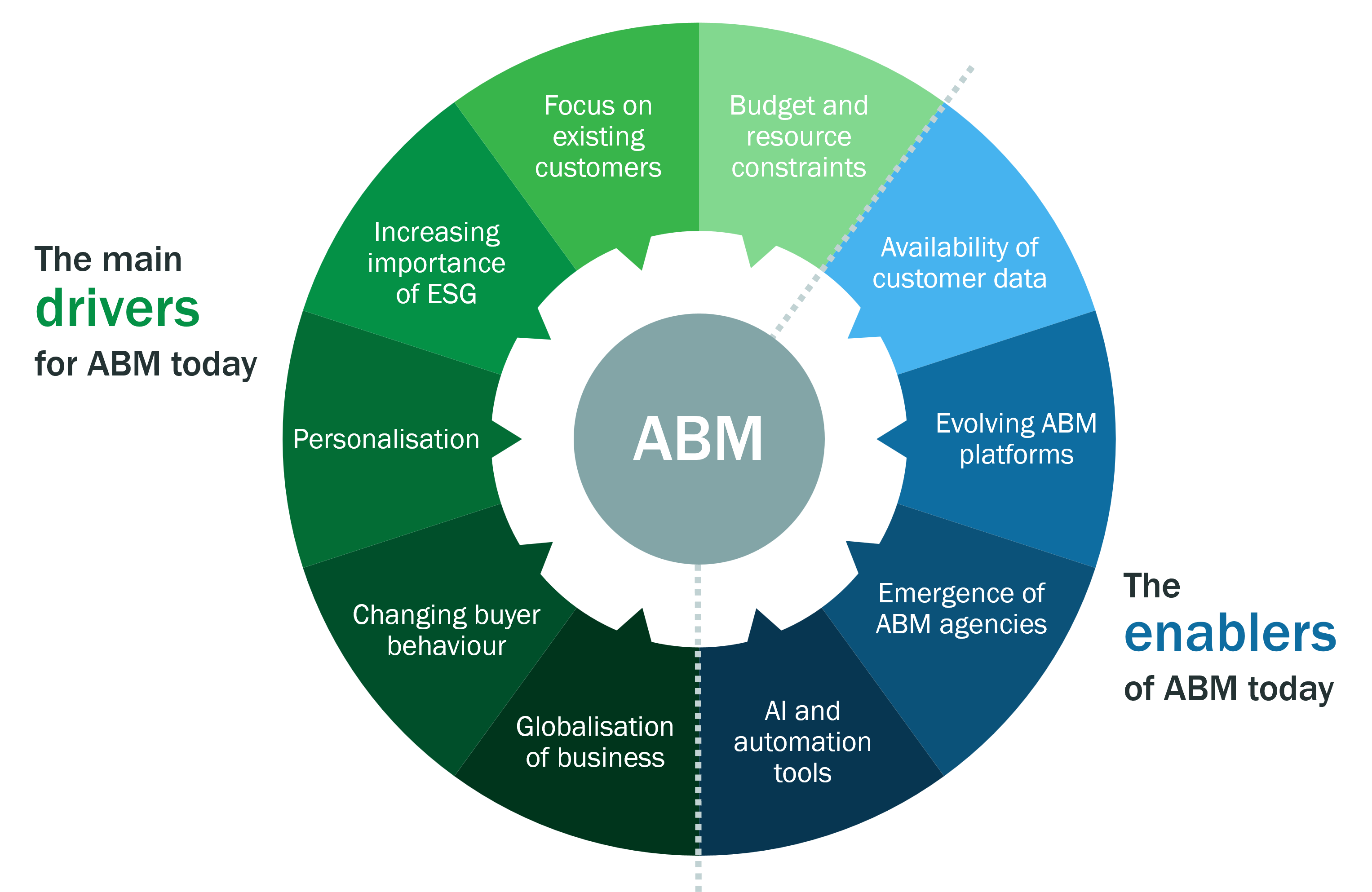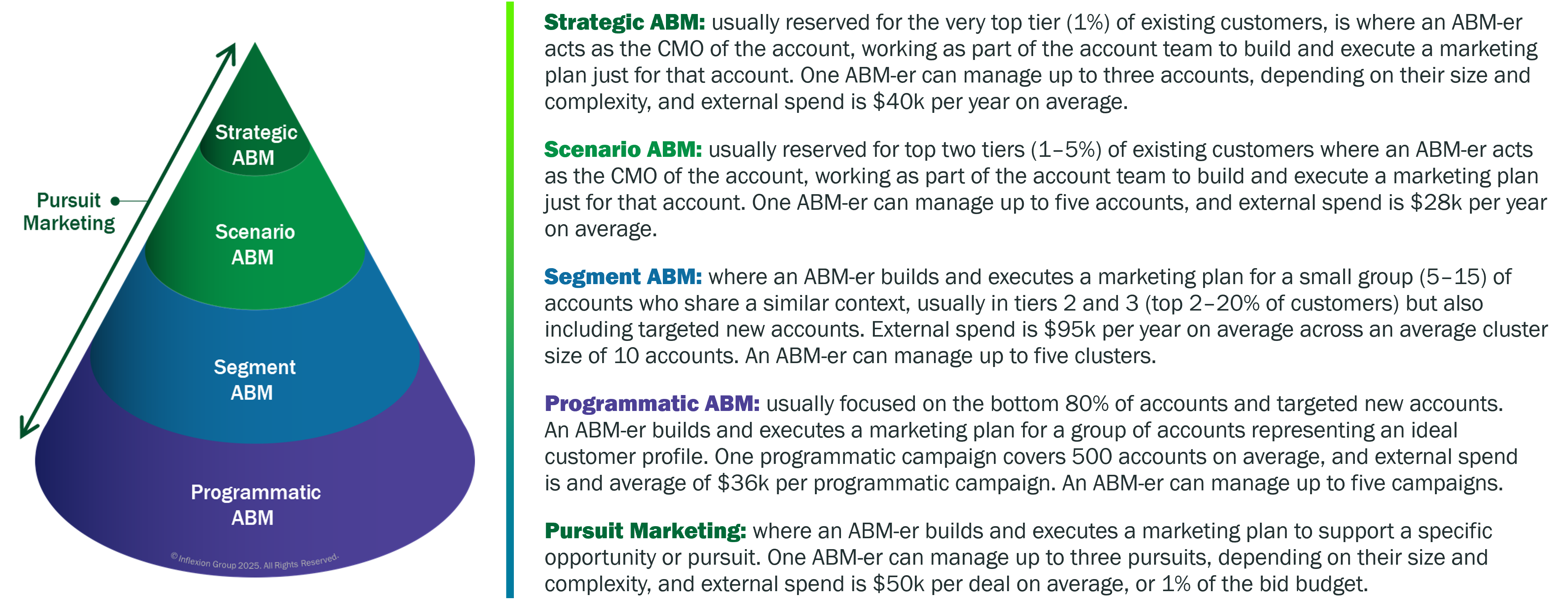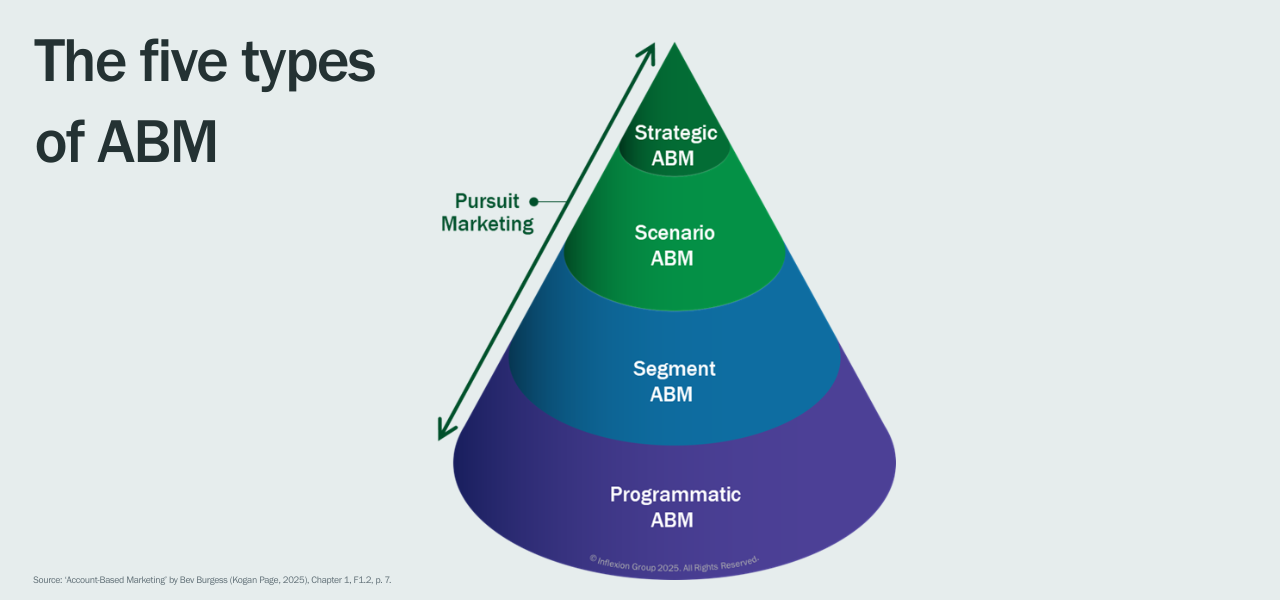Account-based marketing is used by the world’s most successful professional services firms. Bev Burgess explains why.
Since I first codified account-based marketing (ABM) as a marketing approach in 2003, it has reshaped the way we think about B2B marketing. Then, you could count the number of marketers doing ABM on one hand. Today, there are 250,000 people on LinkedIn with ABM in their job titles, and the number is growing. Why?
There are a number of drivers and enablers of an ABM approach, as you can see in Figure 1, but perhaps the most critical of all is the fact that it consistently delivers a higher return on investment than traditional B2B marketing.
Figure 1. Drivers and enablers of an ABM approach

Source: ‘Account-Based Marketing’ by Bev Burgess (Kogan Page, 2025), Chapter 1, Figure 1.3, p. 13.
And as the case studies and interviews in my latest book, Account-Based Marketing, show, professional services marketers are among those increasingly adopting ABM. They are focusing on how to design the right approach for their firm to align with its account management, sales and delivery processes, and how to flex that approach for clients in different sectors and cultures.
The book explores the five types of ABM in play today, often in a blended model to cover more top-tier clients, as shown in Figure 2. These range from Strategic ABM, Scenario ABM (a lighter version of Strategic), Segment ABM (for clusters of clients with similar issues and priorities), Programmatic ABM (tech-enabled and at scale) and Pursuit Marketing.
Figure 2. The five types of ABM

Source: ‘Account-Based Marketing’ by Bev Burgess (Kogan Page, 2025), Chapter 1, Figure 1.2, p. 7.
Here are seven top tips for professional services marketers wanting to adopt a more client-centric approach with ABM, from senior practitioners who are making it work.
1. Prove ABM’s worth by targeting new opportunities in existing clients.
The percentage of your services that a client could buy from you against what they are actually buying is often much lower than you would expect, argues Antonia Wade, Global CMO at PwC. “The opportunity to increase your share of wallet with some of your best, most loyal clients seems like a really smart move as you’re trying to grow,” she says.
Antonia suggests you work with the account teams, identify key stakeholders and create the conversations and meetings that they have struggled to get. This is a sure way to prove marketing’s effectiveness.
2. Get close to the client’s procurement team.
According to Fiona Czerniawska, Founder & CEO of Source Global Research, experts in the professional services sector, the role of the procurement function has become increasingly central to purchasing professional services. “Clients now tell us that the biggest disincentive to using a firm is that they are not on the preferred supplier list. Procurement has established a very strong position, partly through the work they’ve done and partly through other factors, such as economic circumstances and increased regulation.”
3. Become an expert at collaboration in Strategic ABM.
Laura Towers Romano, Senior Manager, Client Relationship Marketing, Accenture, thinks of Strategic ABM as the creation of a strategy specifically geared to address the pain points, grow relationships, and offer relevant solutions within a single client.
The depth of this approach requires an ABM-er to be synchronised with the account leadership team, having a seat at the leadership table and working in lockstep with the team. A collaborative culture makes all the difference, built around “ideation, innovation, fast failure, data-driven decision-making and camaraderie. Sharing these experiences can promote learning among the ABM teams – and business teams.”
4. Be nimble: Focus on driving outcomes in a specific scenario.
Rhiannon Blackwell, ABM Leader, Global Marketing, at PwC, believes that you can streamline the full Strategic ABM approach to focus more tightly on driving specific outcomes for client teams. Scenario ABM still treats the account as a market of one but with a narrower focus, achieving a single outcome over a time-boxed period. She explains: “I think that more organisations are finding that neither Strategic ABM nor one-to-few quite fit the bill for them. As a result, increasing numbers of ABM-ers are inventing their own ABM approaches to suit the needs and nuances of their business.”
5. Think of Segment ABM as a multi-client pursuit.
Jessica Shea, VP Account Marketing at Bain & Company, has strong views on Segment ABM, which she believes is more like multi-client pursuit than Strategic ABM. The opportunity has already been defined and you know what you want to sell to a handful of clients, usually in the same sector, facing similar challenges, and at a similar stage in addressing those challenges.
“The biggest impact is often with white space clients or in new areas of a client organisation,” she explains. “You can use the same approach to talk to each of them and describe how your business can help.”
But this comes with a health warning: “In my opinion, you can’t have a segment campaign with 30, 40, 50 clients in it. It’s nearly impossible to be as pointed and specific with a client list that large – it becomes a sector campaign as you cannot speak to the individual clients personally. The challenge here is managing expectations of sponsors by making sure that you have enough good data to show why you should or shouldn’t allow one of these companies into the mix.”
6. Consider the three Ps of Pursuit Marketing.
One of the specific contexts in which an ABM approach is applied is in pursuing major opportunities, or deals. In fact, if you never identify and pursue an opportunity in your top ABM accounts, you’re doing something wrong!
Typically, Pursuit Marketing is reserved for opportunities with top clients, perhaps in industries where competitive tendering is required (such as the public sector), or where another supplier is the incumbent provider of a service that you wish to compete for. But it may also be used to win significant business with new accounts that you think will become your top customers of tomorrow.
Stephanie Winters McConnell, Managing Director, Pursuit & Reputation Marketing Lead at Accenture, believes that there are three Ps central to making Pursuit Marketing work: Pace, Partnership and Project-Based working. She explains, “We have to make amazing things happen and happen fast.”
7. Embrace AI or get left behind.
Jaspreet Bindra, author of The Tech Whisperer and Master in AI Ethics at Cambridge University warns that “Marketing is probably one of the first functions to be in the crosshairs of generative AI, so if ABM-ers don’t embrace this new technology they will be left behind. ABM-ers should be on the frontline of experimenting with generative AI. There are multiple tools to help you draw insight, build copy, summarise meetings, brainstorm new ideas, create new content at scale, help visualise new content, create beautiful videos using just text as prompts or help target content to specific individuals.”
Here’s a final overarching thought about the integrative value of ABM from the acknowledged ‘father of modern marketing’, Professor Philp Kotler, writing in the book’s foreword. “One of the constant complaints about marketing I have heard throughout my career is that it can operate in a silo, with little reference to other departments. The power of ABM is that it can’t operate in isolation. It has to be thought of and aligned with the way the business engages its accounts, across sales, service, customer success and top executives.”
This article originally appeared in PM Magazine. For further details go to www.pmforum.co.uk.




